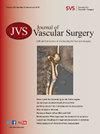Three-year outcomes of a US pivotal trial substudy for conformable endoprosthesis in ≥10 mm nonangulated neck anatomy
IF 3.9
2区 医学
Q1 PERIPHERAL VASCULAR DISEASE
引用次数: 0
Abstract
Objective
To report the midterm clinical outcomes from the GORE® EXCLUDER® Conformable AAA Endoprosthesis system (EXCC) pivotal regulatory trial in the United States (U.S.).
Methods
This is a prospective, multicenter, investigational device exemption clinical trial at 31 U S. sites with Core Laboratory assessment of imaging and independent adjudication of safety. The study enrolled patients with abdominal aortic aneurysms (AAA) with a minimum proximal landing zone ≥10 mm and proximal neck angulation of ≤60 degrees between December 2017 and February 2019 as part of a larger study to gain indications of the EXCC device. Endpoints included patient survival, freedom from secondary interventions, and stent-graft related outcomes.
Results
There were 80 patients enrolled (88.8% male, mean 73.5 ± 8.14 years-old). Mean maximum aortic diameter was 57.7±8.0 mm (range, 42.5-82.7). There was 100% freedom from type I and III endoleak and aneurysm-related mortality at 36-months. Freedom from secondary intervention was 91.9 ± (0.83, 0.96, 95% C.I.) at 36-months. There were no device fractures, migrations (≥10 mm), or aneurysm ruptures. At 36 months, thirteen patients (26.5%) had type 2 endoleak, 32 patients (58.2%) had AAA sac regression, 17 (30.9%) had no change in diameter, and 6 (10.9%) had sac enlargement. Seven patients (8.8%) through 36 months underwent reintervention.
Conclusions
The 3-year outcomes have continued to show an adequate safety and efficacy profile of the EXCC device with no aneurysm related mortality or Type I/III endoleak. These results demonstrate durability for an EVAR device in US regulatory trials.
美国一项关于在 >=10 mm 非弯曲颈部解剖中使用可适形内假体的关键试验子研究的三年结果。
目的:报告在美国进行的 GORE® EXCLUDER® 可适形 AAA 内支架系统(EXCC)关键监管试验的中期临床结果:这是一项前瞻性、多中心、研究设备豁免临床试验,在 31 个美国研究机构进行,由核心实验室对成像进行评估,并对安全性进行独立裁定。该研究在 2017 年 12 月至 2019 年 2 月期间招募了腹主动脉瘤(AAA)患者,这些患者的最小近端着床区≥10 毫米,近端颈部成角≤60 度,是获得 EXCC 装置适应症的大型研究的一部分。终点包括患者存活率、免于二次干预和支架移植物相关结果:共有 80 名患者入选(88.8% 为男性,平均年龄为 73.5 ± 8.14 岁)。平均最大主动脉直径为(57.7±8.0)毫米(42.5-82.7)。36个月后,I型和III型内漏发生率和动脉瘤相关死亡率均为100%。36个月时,无二次干预的比例为91.9 ± (0.83, 0.96, 95% C.I.)。没有发生装置骨折、移位(>=10 毫米)或动脉瘤破裂。36 个月时,13 名患者(26.5%)出现 2 型内漏,32 名患者(58.2%)AAA 囊缩小,17 名患者(30.9%)直径无变化,6 名患者(10.9%)囊增大。7名患者(8.8%)在36个月内接受了再次介入治疗:结论:3 年的结果继续表明 EXCC 装置具有足够的安全性和有效性,没有出现与动脉瘤相关的死亡率或 I/III 型内漏。这些结果证明了 EVAR 设备在美国监管试验中的耐用性。
本文章由计算机程序翻译,如有差异,请以英文原文为准。
求助全文
约1分钟内获得全文
求助全文
来源期刊
CiteScore
7.70
自引率
18.60%
发文量
1469
审稿时长
54 days
期刊介绍:
Journal of Vascular Surgery ® aims to be the premier international journal of medical, endovascular and surgical care of vascular diseases. It is dedicated to the science and art of vascular surgery and aims to improve the management of patients with vascular diseases by publishing relevant papers that report important medical advances, test new hypotheses, and address current controversies. To acheive this goal, the Journal will publish original clinical and laboratory studies, and reports and papers that comment on the social, economic, ethical, legal, and political factors, which relate to these aims. As the official publication of The Society for Vascular Surgery, the Journal will publish, after peer review, selected papers presented at the annual meeting of this organization and affiliated vascular societies, as well as original articles from members and non-members.

 求助内容:
求助内容: 应助结果提醒方式:
应助结果提醒方式:


